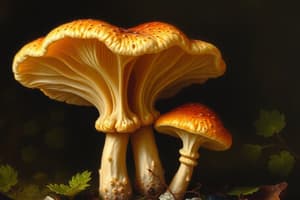Podcast
Questions and Answers
What is mycology?
What is mycology?
- The study of fungi (correct)
- The study of plants
- The study of bacteria
- The study of viruses
What is the optimal pH for molds?
What is the optimal pH for molds?
- 1.0 - 6.0
- 2.2 - 9.6 (correct)
- 3.0 - 7.5
- 4.0 - 8.0
What is the growth form of molds?
What is the growth form of molds?
- Single-celled organisms
- Multicellular aggregates of long branching filaments (correct)
- Clumps of spores
- Thin, thread-like structures
What is the temperature range for mold growth?
What is the temperature range for mold growth?
What is the function of aerial hyphae?
What is the function of aerial hyphae?
What is the characteristic of septate hyphae?
What is the characteristic of septate hyphae?
What is the primary mode of nutrition for fungi?
What is the primary mode of nutrition for fungi?
What is the color of spores produced by molds?
What is the color of spores produced by molds?
What is the characteristic of coenocytic hyphae?
What is the characteristic of coenocytic hyphae?
What is the primary characteristic of hyphae?
What is the primary characteristic of hyphae?
What is the primary characteristic of eukaryotic fungi?
What is the primary characteristic of eukaryotic fungi?
What is the primary characteristic of yeasts?
What is the primary characteristic of yeasts?
Which type of spore is important for human health and can lead to rare fungal infections?
Which type of spore is important for human health and can lead to rare fungal infections?
What is the initial step for true hyphae production in some yeasts?
What is the initial step for true hyphae production in some yeasts?
What is the target for antifungal drugs in the fungal cell membrane?
What is the target for antifungal drugs in the fungal cell membrane?
Which phenomenon refers to the ability of fungi to grow in mold or yeast form based on environmental conditions?
Which phenomenon refers to the ability of fungi to grow in mold or yeast form based on environmental conditions?
What are the two major types of hyphae observed in infected nails under a microscope?
What are the two major types of hyphae observed in infected nails under a microscope?
Which group is not a classification of fungi based on sexual spore types and hyphal morphology?
Which group is not a classification of fungi based on sexual spore types and hyphal morphology?
What is the reproductive mode of yeasts?
What is the reproductive mode of yeasts?
Which fungal structure is primarily responsible for producing slime/biofilm and capsules?
Which fungal structure is primarily responsible for producing slime/biofilm and capsules?
Which type of spore is resistant to unfavorable conditions and easily disseminated in nature and laboratory settings?
Which type of spore is resistant to unfavorable conditions and easily disseminated in nature and laboratory settings?
What are the asexual spore types useful in identifying the mold genus and species?
What are the asexual spore types useful in identifying the mold genus and species?
What is the growth temperature range for yeasts?
What is the growth temperature range for yeasts?
Which term refers to the large, unicellular cells that reproduce by budding and may form pseudohyphae?
Which term refers to the large, unicellular cells that reproduce by budding and may form pseudohyphae?
Flashcards are hidden until you start studying
Study Notes
Fungal Morphology and Classification
- Septate hyaline hyphae and dark pigmented hyphae are observed in infected nails under a microscope
- Mold reproductive spores, such as conidia and sporangiospores, are resistant to unfavorable conditions and easily disseminated in nature and laboratory settings
- Asexual spores divide into four major groups: chlamydospores, arthroconidia, microconidia, and macroconidia, and are useful in identifying the mold genus and species
- Mold spores, such as conidia and sporangiospores, are important for human health and can lead to rare fungal infections
- Yeasts, also known as blastospores or blastoconidia, are large, unicellular cells that reproduce by budding and may form pseudohyphae
- Some yeasts produce additional specific structures, such as germ tube formation, which is an initial step for true hyphae production
- Yeasts grow best at 30-37°C and produce colonies on solid media, and their asexual forms are known as blastosores or buds
- Yeasts can also produce sexual spores, such as basidiospores and ascospores, which are important for their reproduction
- Fungi can grow in mold or yeast form according to environmental conditions, a phenomenon known as dimorphism
- Fungi have subcellular structures including a cell wall, cell membrane, and cytoplasmic content, and produce slime/biofilm and capsules
- The fungal cell membrane contains phospholipids, proteins, and sterols, mainly in the form of ergosterol, which is a target for antifungal drugs
- Fungi are classified into groups based on sexual spore types and morphology of hyphae, such as Oomycota, Zygomycota, Ascomycota, and Basidiomycota, each with distinct characteristics and associations
Studying That Suits You
Use AI to generate personalized quizzes and flashcards to suit your learning preferences.




